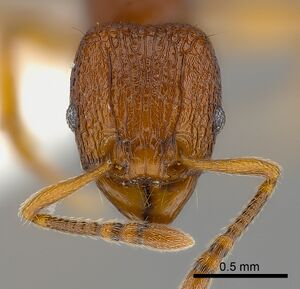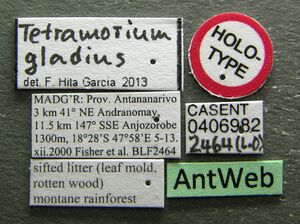Tetramorium gladius
| Tetramorium gladius | |
|---|---|

| |
| Scientific classification | |
| Kingdom: | Animalia |
| Phylum: | Arthropoda |
| Class: | Insecta |
| Order: | Hymenoptera |
| Family: | Formicidae |
| Subfamily: | Myrmicinae |
| Tribe: | Crematogastrini |
| Genus: | Tetramorium |
| Species group: | schaufussii |
| Species complex: | cognatum |
| Species: | T. gladius |
| Binomial name | |
| Tetramorium gladius Hita Garcia & Fisher, 2014 | |
Tetramorium gladius seems to be only moderately common and lives in the leaf litter.
Identification
A member of the Tetramorium cognatum species complex of the Tetramorium schaufussii species group. Hita Garcia and Fisher (2014) - The relatively small eyes (OI 19–20) of T. gladius separate it from the other members of the T. cognatum species complex.
Beyond the relatively small eyes of T. gladius it appears to be morphologically close to Tetramorium myrmidon, Tetramorium proximum, and Tetramorium tenuinode of the T. cognatum species complex. They all share a larger body size and very well developed frontal carinae and sculpture.
Little morphological variation is observed in T. gladius, with the exception, that the propodeal spines are longer in specimens from Ambatovaky (PSLI 26–28) compared to the rest of the material (PSLI 21–24).
Keys including this Species
Distribution
Tetramorium gladius has a relatively wide but patchy distribution in central, central-eastern, and northern Madagascar. The southernmost localities are Ambohitantely and Andranomay and the northernmost is Binara with Ambatovaky, Ambanizana, and Anjanaharibe-Sud in-between.
Latitudinal Distribution Pattern
Latitudinal Range: -13.26333° to -18.47333°.
| North Temperate |
North Subtropical |
Tropical | South Subtropical |
South Temperate |
- Source: AntMaps
Distribution based on Regional Taxon Lists
Malagasy Region: Madagascar (type locality).
Distribution based on AntMaps
Distribution based on AntWeb specimens
Check data from AntWeb
Countries Occupied
| Number of countries occupied by this species based on AntWiki Regional Taxon Lists. In general, fewer countries occupied indicates a narrower range, while more countries indicates a more widespread species. |

|
Estimated Abundance
| Relative abundance based on number of AntMaps records per species (this species within the purple bar). Fewer records (to the left) indicates a less abundant/encountered species while more records (to the right) indicates more abundant/encountered species. |

|
All localities are rainforests and montane rainforests at elevations ranging from 425 to 1490 m.
Biology
Castes
Images from AntWeb
   
| |
| Worker. Specimen code casent0163237. Photographer Estella Ortega, uploaded by California Academy of Sciences. | Owned by CAS, San Francisco, CA, USA. |
   
| |
| Paratype of Tetramorium gladius. Worker. Specimen code casent0406964. Photographer Estella Ortega, uploaded by California Academy of Sciences. | Owned by CAS, San Francisco, CA, USA. |
   
| |
| Holotype of Tetramorium gladius. Worker. Specimen code casent0406982. Photographer Michele Esposito, uploaded by California Academy of Sciences. | Owned by CAS, San Francisco, CA, USA. |
Nomenclature
The following information is derived from Barry Bolton's Online Catalogue of the Ants of the World.
- gladius. Tetramorium gladius Hita Garcia & Fisher, 2014: 79, figs. 21C, 23A, 34, 63 (w.) MADAGASCAR.
Unless otherwise noted the text for the remainder of this section is reported from the publication that includes the original description.
Description
Worker
(N=12). HL 0.71–0.87 (0.81); HW 0.65–0.82 (0.75); SL 0.48–0.58 (0.54); EL 0.13–0.16 (0.15); PH 0.32–0.41 (0.37); PW 0.47–0.61 (0.55); WL 0.87–1.08 (1.00); PSL 0.17–0.22 (0.19); PTL 0.14–0.18 (0.15); PTH 0.24–0.33 (0.29); PTW 0.17–0.22 (0.19); PPL 0.20–0.27 (0.23); PPH 0.25–0.34 (0.30); PPW 0.26–0.34 (0.29); CI 92–95 (93); SI 71–74 (72); OI 19–20 (20); DMI 54–56 (55); LMI 36–38 (37); PSLI 21–28 (23); PeNI 31–36 (35); LPeI 48–58 (53); DPeI 113–133 (124); PpNI 49–56 (53); LPpI 70–82 (78); DPpI 120–133 (125); PPI 148–159 (153).
Head longer than wide (CI 92–95); in full-face view posterior head margin weakly to moderately concave. Anterior clypeal margin with distinct median impression. Frontal carinae moderately to well developed, diverging posteriorly, either merging with surrounding sculpture halfway between posterior eye margin and posterior head margin or only becoming weaker after posterior eye level but still approaching posterior head margin. Antennal scrobes very weak, shallow, and without clear and distinct posterior and ventral margins. Antennal scapes short, not reaching posterior head margin (SI 71–74). Eyes relatively small (OI 19–20). Mesosomal outline in profile flat to weakly convex, moderately low and long (LMI 36–38), moderately marginate from lateral to dorsal mesosoma; promesonotal suture absent; metanotal groove mostly reduced and absent, if present weakly developed. Propodeal spines moderately long to long, elongate-triangular to spinose, and usually acute (PSLI 21–28), propodeal lobes short and triangular, always much shorter than propodeal spines. Petiolar node in profile nodiform to high rounded nodiform, around 1.7 to 2.1 times higher than long (LPeI 48–58), anterior and posterior faces approximately parallel, anterodorsal and posterodorsal margins usually situated at about same height and weakly rounded, petiolar dorsum weakly to moderately convex; node in dorsal view between 1.1 to 1.3 times wider than long (DPeI 113–133), in dorsal view pronotum between 2.8 to 3.2 times wider than petiolar node (PeNI 31–36). Postpetiole in profile globular, around 1.2 to 1.4 times higher than long (LPpI 70–82); in dorsal view around 1.2 to 1.3 times wider than long (DPpI 120–133), pronotum around 1.8 to 2.0 times wider than postpetiole (PpNI 49–56). Postpetiole in profile usually appearing more voluminous than petiolar node, postpetiole in dorsal view around 1.5 to 1.6 times wider than petiolar node (PPI 148–159). Mandibles completely unsculptured, smooth, and shiny; clypeus longitudinally rugose/rugulose with three to seven median ruga always fully developed and distinct, and one to three mostly unbroken lateral rugae/rugulae present on each side; cephalic dorsum between frontal carinae longitudinally rugose with seven to nine rugae, rugae running mostly unbroken from posterior clypeal margin to posterior head margin, sometimes interrupted or with cross-meshes; scrobal area partly unsculptured, but mostly merging with surrounding reticulate-rugose to longitudinally rugose sculpture present on lateral head. Dorsum and sides of mesosoma mostly irregularly longitudinally rugose. Forecoxae unsculptured, smooth, and shining. Ground sculpture on head and mesosoma usually weak to absent. Both waist segments and gaster fully unsculptured, smooth, and shining. Dorsum of head with several pairs of long, fine, standing hairs; dorsum of mesosoma with six to eight pairs on pronotum and mesonotum, anterior propodeum with one pair; waist segments and first gastral tergite without any standing hairs; first gastral tergite with very short, scarce, appressed pubescence. Anterior edges of antennal scapes and dorsal (outer) surfaces of hind tibiae with appressed, rarely decumbent hairs. Head, mesosoma, waist segments, and gaster uniform reddish, orange-brown, appendages always lighter, yellowish to light brown.
Type Material
Holotype, pinned worker, MADAGASCAR, Antananarivo, 3 km 41° NE Andranomay, 11.5 km 147° SSE Anjozorobe, 18.47333°S, 47.96°E, 1300 m, montane rainforest, sifted litter (leaf mold, rotten wood), collection code BLF02464, 5.–13.XII (B.L. Fisher et al.) (California Academy of Sciences: CASENT0406982). Paratypes, one pinned worker with same data as holotype (CAS: CASENT0406981); four pinned worker with same data as holotype but collected ex rotten stick on ground and collection codes BLF02407 and BLF02408 (CAS: CASENT0406964; CASENT0406971); fifteen pinned workers with same data as holotype but collected ex rotten log and collection codes BLF02429, BLF02498, and BLF02500 (CAS: CASENT0406966; CASENT0406967; CASENT0406968; CASENT0406969; CASENT0406974; CASENT0406975; Museum of Comparative Zoology: CASENT0406976); one pinned worker with same data as holotype but collected ex rotten tree stump and collection code BLF02486 (The Natural History Museum: CASENT0406965).
Etymology
The name of the new species is the ancient Latin general word for sword, although it mostly refers to the short swords used by foot soldiers of the Roman legion. The name was chosen based on the shape of the propodeal spines in most specimens of T. gladius, which resemble this type of sword. The species epithet is a nominative noun, and thus invariant.
References
References based on Global Ant Biodiversity Informatics
- Hita Garcia F, and B. L. Fisher. 2014. The hyper-diverse ant genus Tetramorium Mayr (Hymenoptera, Formicidae) in the Malagasy region - taxonomic revision of the T. naganum, T. plesiarum, T. schaufussii, and T. severini species groups. ZooKeys 413: 1-170.

